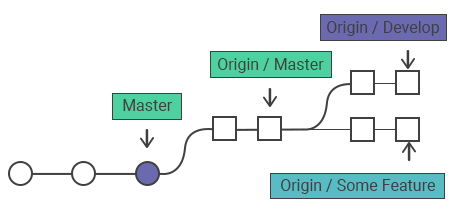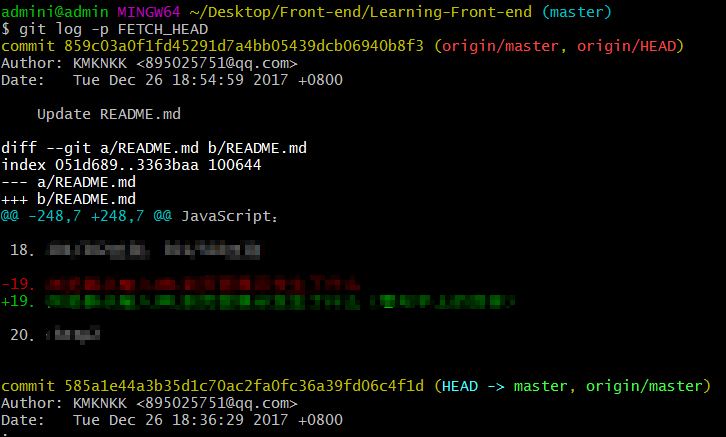
I like option 2 as I don't need to checkout dev, but both options are equally correct. git clone -depth 1 git:///pythonwebkit.git cd pythonwebkit git branch -a master remotes/origin/HEAD -> origin/master remotes/origin/master git -version git version 1.8.3.

This is OK, since b isn't working on dev, (s)he's working on feature_branch. In this scenario b's local feature_branch will have the most recent changes from dev as they are on the remote repo and their local dev will not have these changes. git merge origin/dev - this merges changes from the downloaded version of dev to the feature_branch.git fetch origin dev - this downloads latest changes to dev, but doesn't merge them to local dev.With this option b's both local dev and feature_branch have latest changes. git merge dev - this merges changes from b's local dev to the feature_branch.Once fetched, one can git branch -remote to list the tracking branches and git checkout branch to actually switch to any given one. This operation should normally be a 'fast-forward' (so no merge conflicts) This is done via a git fetch which will get all new and changed branches into the locally repository using the tracking branches (e.g., origin/). git pull - this fetches (downloads) the changes onto computer b and merges these changes into the currently checked out local branch on computer b (in this case branch dev).Commit all changes to branch feature_branch (git status shows clean).
#Git fetch a branch code
This is so that person B works on latest code and their eventual merge to dev is easy. The challenge I have is knowing what the latest code on the FOO_3_4_0001_INITIAL branch is.It's a good practice to as soon as feasible after person A pushes the changes to dev for person B to get these changes into their branch b. When a programmer fixes a bug or adds a new feature, he or she. The Git branch command creates new branches. Ok, more info for and I run git branch -r, I see: 16:12:02 (1) foo $ git branch -rĪnd if I look at the list of tags, I see, among other things: 16:12:05 (1) foo $ git tag -l In Git, a branch is a separate line of development. If I check out the code tagged FOO_3_4_0001_RC5a my change is there. Remote: Total 61 (delta 18), reused 0 (delta 0)Īt this point I checked for the change I made on this branch and it's not there. We see that the branch html-skeleton is available remotely, but not on our local git. Remote: Compressing objects: 100remote: % (59/59), done. Note: branch -r is for remote branches only.

Switched to a new branch "FOO_3_4_0001_INITIAL" git fetch List remote branches containing the name 'selva' branches (git branch -r grep 'depid') Create an empty array to store filtered branches filteredbranches () Loop through each branch for branch in branches do Check if the branch has commits in the last 30 days if git log -1 -since'30 days ago' -prettyformat:'' -a.
#Git fetch a branch update
I tried this: 16:19:29 (1) foo $ git checkout -track -b FOO_3_4_0001_INITIAL origin/FOO_3_4_0001_INITIALīranch FOO_3_4_0001_INITIAL set up to track remote branch refs/remotes/origin/FOO_3_4_0001_INITIAL. The script simply uses git fetch -all -prune to update all remote references ( -all ) and drop deleted ones ( -prune ). I have already arranged the lynching didn't work. It turns out that tag FOO_3_4_0001 was not on the 3.4 branch and that's what I was missing all along. How can I check?ĮDIT 2: Thanks to everyone who contributed answers. tags all mark points along the branch kicked off with FOO_3_4_0001_INITIAL. If I fail to tag the end of the branch, however, how do other users get the head of the branch? WHen they use git checkout to fetch the branch they get the code at the point of the branch - not the head of that branch.ĮDIT: I came into this project late and was involved in the CVS to GIT conversion. ), make some changes, then push them back. Both have no co-relation whatsoever, unless either youre trying to switch to a branch that is newly created in the remote and its local version doesnt exist on your system. git checkout can be used to switch branches.
 Sorry for the original inaccurate question. git fetch updates the origin/
Sorry for the original inaccurate question. git fetch updates the origin/You can then do a git checkout -t remotes/repo/branch to the remote and create a local branch.

I can fetch a local copy of one of those branches (git checkout -b. What does git fetch exactly do Ask Question Asked 6 years ago Modified 3 years, 10 months ago Viewed 21k times 20 Edit: I have checked this What does FETCHHEAD in Git mean before asking the question. Use git branch -a (both local and remote branches) or git branch -r (only remote branches) to see all the remotes and their branches. We've got a repository with a number of branches in it. I'm struggling to understand something about GIT.


 0 kommentar(er)
0 kommentar(er)
